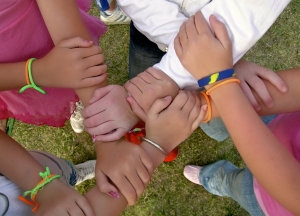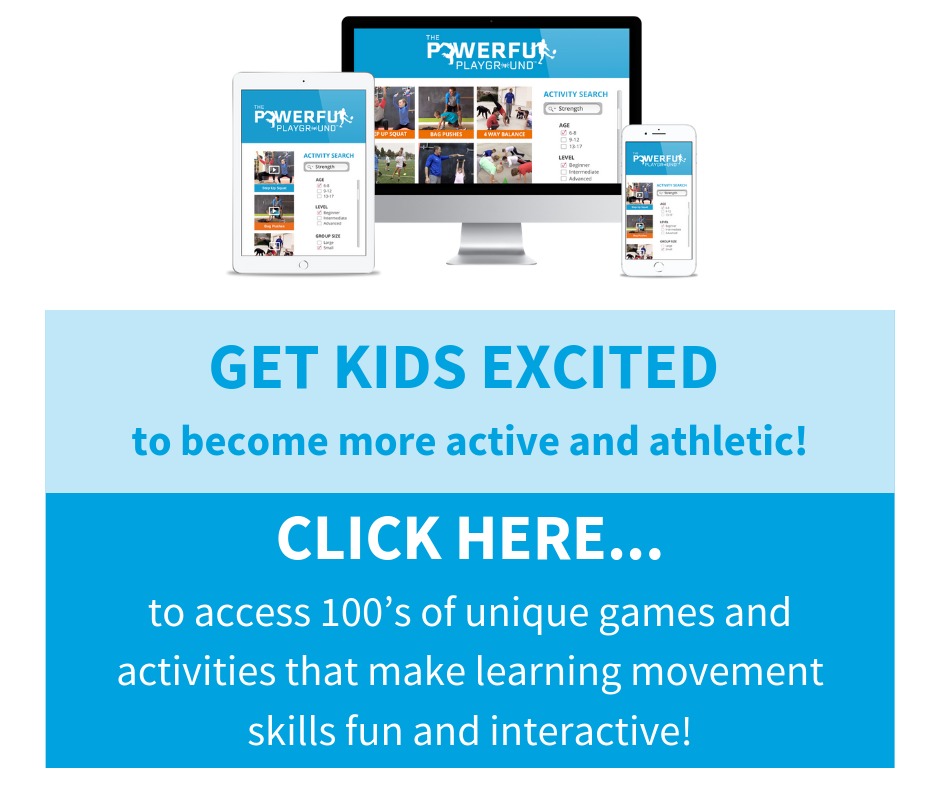By Craig Valency, MA, CSCS
 As I discussed in the first post of this series, the missing link to true movement mastery is learning the 9 perceptual-motor skills as early as possible.
As I discussed in the first post of this series, the missing link to true movement mastery is learning the 9 perceptual-motor skills as early as possible.
As fitness professionals, teachers, therapists, and parents, we have a unique opportunity to even the playing field by offering every child we work with an ideal environment to explore movement through all their senses.
These skills lay the foundation for an increased movement vocabulary with overall better coordination and the ability to learn the fundamental movement skills. With this foundation firmly in place, children are better equipped and more likely to engage in sports and recreational activities for a lifetime.
Here is a bird’s eye view of the 9 perceptual-motor skills I’ll discuss in this series:
- Body: Understand the parts of the bodies and how they move
- Directional: Differentiate between the left and right sides of the body and move in all planes of motion
- Spatial: Has a sense of how much space one’s body takes up and moves comfortably around other people and objects
- Temporal: Has a sense of timing and rhythm
- Visual: Can visually focus and track objects
- Vestibular: Develop an internal sense of their body’s position in relation to gravity
- Auditory: Can accurately respond to sound
- Tactile: Can respond to touch in competitive situations to counter a move, as in wrestling, or in cooperative situations to stay with a partner, as in dance
- Proprioceptive: Interpret the internal sense of where the body is in space
Today, I’m focusing on body awareness and discussing why it is so important. I’ll outline what it is and give specific ideas that you can use to teach body awareness in any youth fitness program.
What is Body Awareness?
Body awareness is simply an understanding of what the various parts of the body are and what they can do. Body awareness also deals with how each body part relates to the other as well as the natural, opposing limb movement patterns, and how to effectively move the body to accomplish a task.
In older kids and adults, a good sense of body awareness is also important in understanding what part of the body should “feel” an exercise or movement. By understanding the basic joints and muscles that are responsible for specific movements, they can better focus on what parts of the body should be doing the work. For instance, when doing a hip bridge on their back, kids might say they feel it in their low back or hamstrings instead of their hips and glutes. When squatting, they may feel it in their knees or thighs, rather than in the hips and glutes because they are driving their knees forward as they squat rather than pushing their hips back. By bringing awareness to where they should feel it, they develop a better innate understanding of proper mechanics.
When I first started working with elementary kids, I made a huge mistake in assuming that they understood what the parts of their body are called and what they can do. This led to frustration and ineffective use of our time, as the kids didn’t always know what I was talking about. I just thought they weren’t listening or following directions properly –or, worse yet, that they were just uncoordinated!
Teaching Body Awareness
A great way to teach body awareness without making anyone feel singled out is to do a whole class activity as a warm-up.
Simply call out body parts and have the kids touch that part. For instance, “Touch your arm. Touch your elbow! Touch your heel. Touch your shin,” etc. At first, you don’t need to be concerned with how they touch it or which hand they use. Start with just a few parts and expand those to more difficult, specific, or obscure parts over time. For older kids, you can use this strategy to help them learn the muscles, bones, and organs of the body. For example, you might say, “Touch your hamstrings. Touch your gastrocnemius!” or “Where are your kidneys? Where is your heart? What about your tibia?”
To make it more entertaining and challenging, you can turn it into a game of Twister –and you don’t even need a mat! Try calling out some more complex commands. For instance, “Touch your right knee with your left elbow,” or, “Put your left knee on the ground, your right index finger on your right ankle, and your left fist in the air.” You’ll get a laugh out of the kids, and they’ll improve their body awareness in the process.
Now that they are learning the specific parts of the body, it is time to add the function of those parts. Teach the verbs associated with each body part, such as grip, flex, extend, rotate, bend, twist, etc. Now just add those to the warm-up game. “Rotate your left wrist, and flex your right foot,” or, “Twist your torso while flexing your knees.”
Use Discovery-based Teaching Techniques
The next level of body awareness activity is to get them to figure out ways their bodies can move by giving them open-ended movement challenges using discovery-based teaching techniques.
For instance, start by asking them to grab imaginary bubbles. Then tell them to flick those bubbles and stomp on them with their heels, and then their toes! You can kick it up a notch by having them grab bubbles with one hand, flick them with the other, and stomp with one foot.
You can now have them do locomotion tasks, such as moving across the floor with these variations:
- on hands and knees
- just elbows and feet
- 2 hands and one foot
- tummy pointing toward the ceiling
- keeping the knees bent.
Another discovery angle is to have them come up with 5 ways they can move their bodies across the floor, or 3 ways they can move their hands. You can then challenge them to move across the floor as various animals and let them interpret how that should look. Don’t correct them; simply give clues if they are not familiar with the animal. For instance, “Turtles move slowly,” “A snake has no arms or legs,” and “A Kangaroo bounces to get around.”
Now try using creative imagery to see what they come up with. For instance, tell them the whole floor is covered in sticky gum and they have to walk across it, or that they are in outer space and they are floating across the field.
Conclusion
The key to teaching body awareness is to start with the most basic body parts and make sure everyone is on the same page. Add more obscure body parts and get them moving more than one part at a time so they develop whole body movement awareness. Next, teach the most basic movement patterns at each joint and then combine those in fun ways to move the whole body. Finally, allow the kids to explore the ways their bodies can move by giving open-ended suggestions and verbal pictures with no “right” or “wrong” outcomes.
In part 3, I’ll talk about directional awareness and show how incorporating many of these fun activities can lead to a greater internal and external awareness of all the planes of motion.
Craig Valency, MA, CSCS, president and co-founder of SPIDERfit, has been a personal trainer for the last 11 years. He is currently working at Fitness Quest 10 in San Diego, an elite personal training and athletic conditioning facility. He specializes in youth strength and conditioning programs that promote physical literacy, injury prevention and optimal performance. Along with training youths from 6 to 18 years of age for general fitness, Craig has also worked with some of the top junior tennis players in the world. He has been a physical education consultant for the Stevens Point school district in Wisconsin for the last 3 years, helping revamp the district wide programming for the K-12 PE curriculum. Craig earned his bachelor degree from UCLA, and Masters Degree in Kinesiology from San Diego State University.





Connect with SPIDERfit!